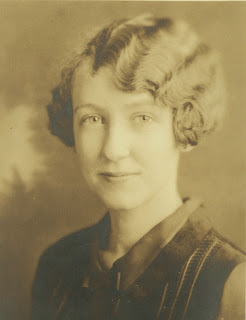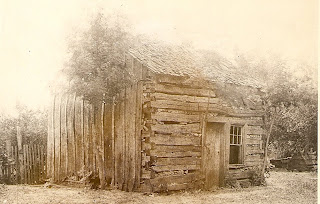Scrawled across the top of the letter with the drawing of a hand pointing to a stain on the paper is this line "some of Jennies tomato preserves."

Dearest Maud:
Your letters always portray and reflect your feeling, and especially so this last one for you are always so open hearted and good, that try as you might to hide it, it always creeps in and while I always feel and sympathize with you, I long for the time when we can put our heads together and tell each other just what we think and feel in ourselves and of others.
I always have had a faculty of putting myself ‘in’ and it may show itself some in this letter as regards Edna.
I am aware that she gets things mixed, but it may all be due to her over eagerness to tell something new or excite curiosity or comment in others rather than injure anyones [sic] feelings.
Edna has a large heart and I believe means well. The way I look upon the stories and there [sic] effect is this, that you and the family are well and favorably known every where you have been both at school and at home, and I have a poor opinion of a person that would allow some little floating hearsay story upset their idea of my character or as much as create a doubt.
The fact is all of you have a reputation Edna can not approach as yet and consequently your force of character is greater, another thing if it be true that things are misrepresented the fact that some one storied travels just as fast as the story itself and consequently has no weight and especially not with your friends, so I would not be alarmed in the least, but take it pretty much as all being in a lifetime unless you hear false reports that might prove serious and it would be time then to take Edna to task, but I’m not afraid but that your reputation will remain untarnished.
I intended going to a surprise party tonight dressed all up, fixed up the buggy, but when I went to get my company was informed that the party was postponed, and I was glad of it because I have been to one dance this week.
I took Misses Louie Patten and Leporin [?], and Miss Patten said right before Miss Leporin that she heard I was to be married soon, I told her I would hate to dissapoint [sic] her, but I dare say she never guessed how near I told the truth.
You said so many nice things to me in your letter, that I can’t adequately meet them in a reply but would sooner show appreciation by answering in person.
What was going on at Manhattan last week. I felt all week as if I ought to go and see you and I didn’t know why or what about, and explained it only by intuition.
I will try and make you a two days visit Xmas vacation, either before or after Xmas.
If it be true you can’t hardly study since I visited last, or as you say three months afterwards, perhaps I had better stay away, for you know I said I didn’t want our engagement to hinder your studying.
Of course I wouldn’t be willing to admit but what there are other things as important as schooling.
I feel as if I needed someone to help me at times, as I get tired planning by myself. Being here alone now as I am, I’m afraid I get ‘bossy’ at times, and make Louie ‘toe the mark’ and I need someone to hold me down a little.
I hope you get this Sunday afternoon. I received your letter tonight.
I suppose my darling little girl is asleep by this time, she should be (10 o’clock) if she is not baking bread.
Mattie put a little note in the bottom of your letter in pencil, this way
Dear Mamma, I will be home Xmas. Mattie
Whether she meant it as a joke on you, and forgot and wrote her own name or got her letter home and yours to me mixed is a question to me.
I’m going to roll in my little feather bed now so my best love to you and kindest friendship to Edna.
Ever your loving Henry
The directors of the Creamery Co. elected me President and secretary both, of the company which adds greatly to my correspondence and outside work. We will charter at $10000. The Creamery is making butter now.

Matfield Green KS
Nov. 20 00
My Darling Maud–
I know my little girl is somewhat disappointed [sic] this week and all on my account and she’s thinking how to treat me in return, whether to scold or like the good samaratin [sic] return good for evil and let it go as a mishap because she didn’t get my letter Sunday afternoon as she hoped and perhaps walked away down town to get it.
I guess boys are real naughty sometimes and one in particular.
It is with a hope that this letter may partly atone for the one you didn’t get, that I write it, and also because whenever I have a quick moment to myself my thoughts wander to you and I want to express them.
I sent Tom after the mail tonight and then took a doze with my feet on the stove and chair leaned back. I guess I got to thinking seriously about some things, and it occurred to me I better write to you, but I’m afraid to say half what I thought I would.
I have read your last letter a number of times trying to study out your full meaning and determine whether you were more than half in earnest.
The trouble is I believe we want to get each other to express their feeling first, because each of us are afraid that something we wish, or would like to have done, would too greatly discommode or inconvenience the other, and that’s why I’m afraid to say half what I feel and desire. I didn’t know I was so timid until it came to a test. Another way would be to ask and let you refuse (or accept as you might wish).
If you accepted all would be well and if not, things would go on as smoothly as before until the time set. I have said just enough now to make you wonder whether I am going to say more or not, but I thought from your last letter that I was given permission to break the “ice.” (Just so I don’t meet with an icy reception after it is broken.)
I guess I take myself altogether to [sic] seriously, but if any new arrangements are to be made it is high time to make them, both on your account and mine.
I wish we had talked over plans more fully when we talked of them before. But I know I have no business talking this way after having things definitely settled.
Perhaps the best way to do would be to ask you questions.
You have your mind fully made up to graduate haven’t you and your mother wants you to don’t she?
Is Mattie coming home Xmas?
Do you still think of taking that course in dressmaking next summer?
If we by any accident should get married before next Xmas—a year, would you want to make your eastern trip at that time?
If we should get married before next fall would you want that kitchen built, or would it be better to live here until my lease is up, which is a year commencing Jan. 1st? You would know then better what you wanted to go over there.
The foregoing questions ought not be asked at this stage but it is of twofold interest to me as regards renting my land for another year.
Some way I can’t express my self. I ought to be in Manhattan and then I would somehow know what you wanted to do.
If there are any questions you wish to ask me don’t be a bit backward because I feel the need of a little closer understanding between us.
You can probably see the trend of my whole letter without any trouble. To be plain do you want to be Mrs. Rogler this coming Xmas or winter, or do as we first agreed. Whichever course you choose will be satisfactory with me.
Your ever loving Henry
Don’t answer this letter if you think it out of place.
I wrote to you Sat. but was off hunting (?) and missed hack [by] a few minutes—I felt real sorry.









